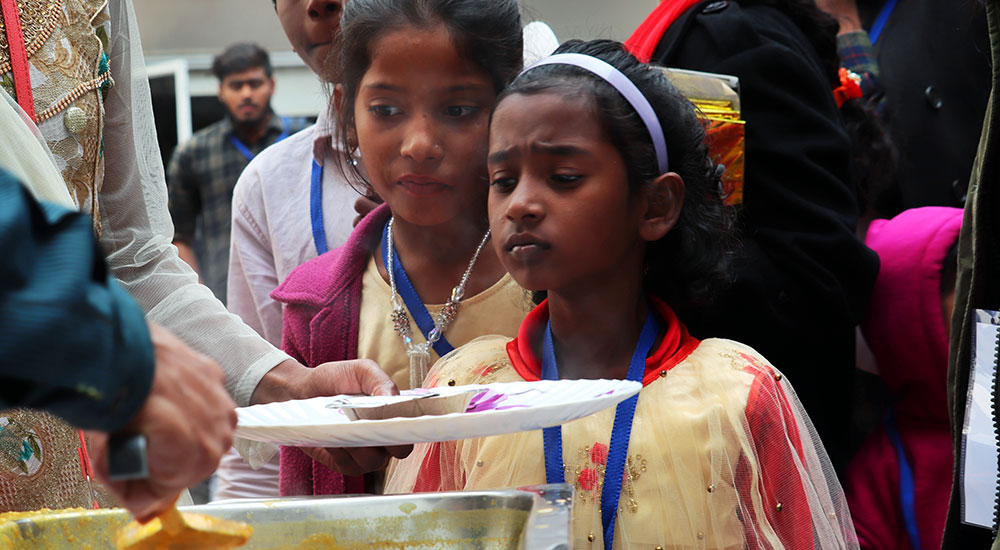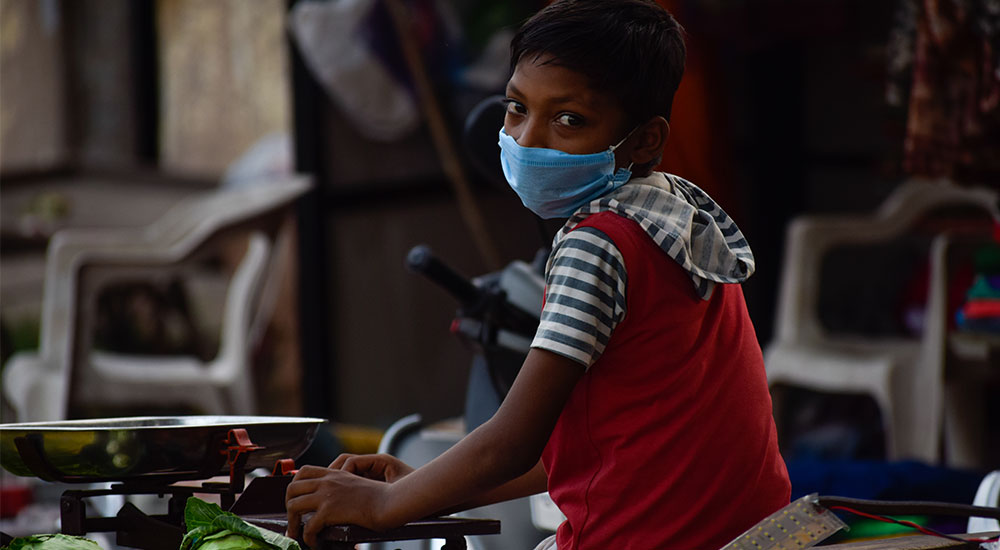The linkage between malnutrition and susceptibility to viral infections becomes especially important in the face of the Coronavirus pandemic

The whole world is reeling under the impact of a pandemic, a viral infection caused by COVID-19, more commonly known as the Coronavirus infection. Coronaviruses, including the newly discovered COVID-19, are a group of viruses that belong to the family Coronaviridae1. The virus originated in China’s Wuhan province and rapidly spread to other countries. It has affected more than 210 countries and territories around the world2.
Infected persons usually show respiratory or flu-like symptoms such as cough, fever, shortness of breath, and so on, within 2-14 days after exposure to the virus3. The good news is that most patients usually experience mild to moderate severity of the illness and recover without requiring special treatment. However, older patients and those with pre-existing medical problems like cardiovascular disease, diabetes, chronic respiratory disease, or cancer are more likely to be serious4 and the disease may even prove fatal. The virus spreads primarily through droplets of saliva or discharge from the nose when an infected person coughs or sneezes3. As there are no specific vaccines or treatments available currently, the only ways to reduce the spread of the disease are - practicing respiratory etiquette, observing social distancing, maintaining hygiene, and washing your hands thoroughly.
As of April 14th 2020, 1,926,149 people all around the world have been infected of which 119,724 have lost their lives to the infection.2 As researchers around the world desperately try to develop a vaccine and the prophylaxis for it, governments have been working on a war footing to control the spread of the virus and minimize the number of fatalities resulting from it. Although too early to confirm, the virus is said to share certain similarities with other virus strains such as Severe Acute Respiratory Syndrome (SARS) SARS and Middle East Respiratory Syndrome coronavirus (MERS-CoV). As scientists are still working on the exact nature of the similarities, certain common precautionary measures have been advised to the general public.
It would also be noteworthy to assess the status of malnutrition and susceptibility to viral infections through the lens of other similar viral diseases/epidemics/ endemic case studies. As the COVID-19 is a newly discovered virus, confirmed information available about it is limited. However, a study of similar experiences with previous episodes of infections would help develop possible measures to ensure preparedness for the future.
Malnutrition and immunodeficiency
Malnutrition is a major factor responsible for increased morbidity and mortality in a population. Malnutrition usually results from disordered nutrient assimilation or recurrent infections and chronic inflammation, which could be the result of an underlying immune defect5. Studies have shown that immune dysfunction can be both a cause and a consequence of malnutrition. Immune dysfunction can directly drive pathological processes in malnutrition, including mal-absorption, increased metabolic demand, dysregulation of the growth hormone, and greater susceptibility to infection5.
Malnutrition is not just a result of inadequate food intake but also improper nutrient intake and poor diets leading to consequences such as obesity and diabetes. Characterizing pathogenesis across the spectrum of malnutrition is essential to underpin novel therapeutic approaches5 to support international goals to improve nutrition, health, and well-being6.
Even common infections can be fatal to undernourished children implying that mortality is related to underlying immunodeficiency even in mild forms of under-nutrition8. Infections are also more common and more severe in people with obesity9. Immune dysfunction can also arise before birth via developmental pathways, compounded by environmental and behavioural factors, particularly those experienced during early life.5
A condition that results from a genetic or developmental defect in the immune system is called a primary immunodeficiency.10 Secondary or acquired immunodeficiency is the loss of immune function that results from a variety of extrinsic factors.10
Immune Defects in Undernourished Children

Studies have shown certain hindered immunity parameters in undernourished children (age 0–5 years).7 As characterisation of immunodeficiency was limited, especially for mild and moderate malnutrition, the precise nature of immunodeficiency in undernutrition is thus, uncertain. However, available evidence does show that both innate and adaptive immunity are impaired by malnutrition5.
One’s innate immune system is the first line of defence specified to confine infection in the early hours of exposure11. An adaptive immune system provides protection from infections that cause disease and death, by defending the body from pathogens. Unlike innate immune responses, the adaptive responses are highly specific to the particular pathogen that induced them12.
Defects in innate immune function include impaired epithelial barrier function of the skin and gut, reduced granulocyte microbicidal activity, fewer circulating dendritic cells, and reduced complement proteins, leukocyte numbers and acute phase response are preserved.5 Defects in adaptive immune function involve reduced levels of soluble IgA in saliva and tears, lymphoid organ atrophy, reduced delayed-type hypersensitivity responses, fewer circulating B cells, and so on, but lymphocyte and immunoglobulin levels in peripheral blood are preserved.5 However, most malnourished children usually respond adequately to vaccination, although the timing, quality, and longevity of vaccine-specific responses may be impaired13.
Co-relation between micro-nutrient deficiencies and susceptibility to infections
Malnutrition can be a consequence of energy deficit (protein-energy malnutrition - PEM) or a micronutrient deficiency and in both cases is still a major burden in developing countries. It is considered the most relevant risk factor for illness and death, particularly affecting hundreds of millions of pregnant women and young children.10
A seemingly healthy child might also be more susceptible to viruses if suffering from micro-nutrient deficiencies which often go unnoticed. Together, infections and micronutrient deficiencies can induce immunodeficiency in otherwise healthy children, increasing their susceptibility to viral infections as well as other ailments. A sick person’s nutritional status is further aggravated by diarrhoea, mal-absorption, loss of appetite, diversion of nutrients for immune response, and so on. All of these lead to nutrient losses and further hinder the body’s defence mechanisms, with fever also increasing both energy and micronutrient requirements14. Malnutrition thus, magnifies the effect of disease and vice versa.
Malnutrition is the leading cause of immunodeficiency in human beings. Multiple studies have proven that the immune system cannot function optimally in the presence of malnutrition15. There is a direct relationship between malnutrition and immunodeficiency as reflected through the susceptibility to infections caused by influenza and Zika viruses.
Case study 1:Vitamin A helps maintain the integrity of the epithelium in the respiratory and gastrointestinal tracts and its deficiency increases the risk of diarrhoea, plasmodium falciparum malaria, measles, and overall mortality16. Measles, estimated to kill two million children per year17, is closely linked to Vitamin A deficiency. Children who are already deficient in Vitamin A are at a much greater risk of dying from measles. Thus, vaccination against measles often includes a high dose of Vitamin A. Furthermore, measles also depletes the body's supply of vitamin A and is likely to aggravate other existing nutritional deficiencies.17 Studies have shown that Vitamin A deficiency also increases the risk of developing respiratory diseases19. Alarmingly, according to World Health Organisation (WHO) an estimated 250 million preschool children are Vitamin A deficient and it is likely that in vitamin A deficient areas a substantial proportion of pregnant women are vitamin A deficient20. |
Case study 2:Zika virus or the Zika fever causing virus, is an arthropod-borne viral disease, first discovered in Uganda in the late 1940s21. Zika virus transmitted to people through the bite of infected mosquitoes belonging to the Aedes species22. It was found that the virus first spread rapidly in countries with high rates of malnutrition that was a result of energy deficit (protein-energy malnutrition) or a micronutrient deficiency.21 In 2007, the first documented outbreak of Zika virus disease was reported in Yap State, Federated States of Micronesia when about 73% of the population below three years of age was estimated to have been infected.21 Subsequent outbreaks occurred in Southeast Asia and the Western Pacific. In December, Brazil’s Ministry of Health estimated that 440,000–1,300,000 suspected cases of Zika virus disease had occurred in Brazil in 201523. The virus spread to different regions of Africa and Southeast Asia, in addition to diverse Pacific Islands, South America and the Caribbean. |
Way forward- Nutritional security as the first line of defence
A malnourished person has more severe disease episodes, more complications, and spends more time ill for each episode . Thus, malnutrition and the susceptibility of a person to infectious diseases is not only closely linked but is also a vicious cycle of infection, reduced immunity, and deteriorating nutritional status, leading to consequences such as impaired child development, compromised immunity leading to infections and diseases, reduced productivity, poverty, impaired development of education and health system, and socio-economic and political instability.24
Recommendations:
- Use of government mechanisms such as the PDS (Public Distribution System), Mid-day Meal and the ICDS (Integrated Child Development System) for the distribution of vitamin supplements, especially to the most vulnerable populations.
- Extensive public awareness campaign involving government, media, public figures etc. about the significance of good nutrition, especially with regards to micro-nutrients to improve immunity against the virus. This can be on the lines of the current awareness campaigns being carried out to encourage sanitary practices among the public to protect themselves from Coronavirus infection.
- The learnings from the current Coronavirus outbreak should be used to tackle similar situations in the future by increasing our preparedness for the same, especially with respect to measures by the government (rapid testing, early detection and isolation, sufficient medical equipment, etc.) and by citizens (increasing personal immunity, improving nutritional quality of available food, personal hygiene, etc.).
Footnotes
1. https://www.who.int/docs/default-source/coronaviruse/who-rights-roles-respon-hw-covid-19.pdf?sfvrsn=bcabd401_0
2. https://www.worldometers.info/coronavirus/#countries
3. https://www.cdc.gov/coronavirus/2019-ncov/symptoms-testing/symptoms.html
4. https://www.who.int/emergencies/diseases/novel-coronavirus-2019
5. https://www.ncbi.nlm.nih.gov/pmc/articles/PMC4889773/
6. https://sustainabledevelopment.un.org
7. https://www.ncbi.nlm.nih.gov/pubmed/15794969
8. https://www.ncbi.nlm.nih.gov/pubmed/23734210
9. https://www.ncbi.nlm.nih.gov/pubmed/20610324
10. http://www.scielo.br/scielo.php?script=sci_arttext&pid=S1678-91992009000300003
11. https://www.sciencedirect.com/topics/immunology-and-microbiology/innate-immune-system
12. https://www.ncbi.nlm.nih.gov/books/NBK21070/
13. https://www.ncbi.nlm.nih.gov/pmc/articles/PMC4527386/
14. https://academic.oup.com/cid/article/46/10/1582/294025
15. https://www.longdom.org/open-access/protein-energy-malnutrition-and-susceptibility-to-viral-infections-as-zika-and-influenza-viruses-2155-9600-1000489.pdf
16. https://www.ncbi.nlm.nih.gov/pmc/articles/PMC1195969/
17. https://www.ncbi.nlm.nih.gov/pubmed/3176515
18. https://www.ncbi.nlm.nih.gov/pmc/articles/PMC1195969/
19. https://www.ncbi.nlm.nih.gov/pmc/articles/PMC6164133/
20. https://www.who.int/nutrition/topics/vad/en/
21. https://www.longdom.org/open-access/protein-energy-malnutrition-and-susceptibility-to-viral-infections-as-zika-and-influenza-viruses-2155-9600-1000489.pdf
22. https://www.cdc.gov/zika/prevention/transmission-methods.html
23. https://www.medscape.com/answers/2500035-26877/what-is-the-global-prevalence-zika-virus-infection
24. https://www.who.int/diseasecontrol_emergencies/publications/idhe_2009_london_malnutrition_fenn.pdf

